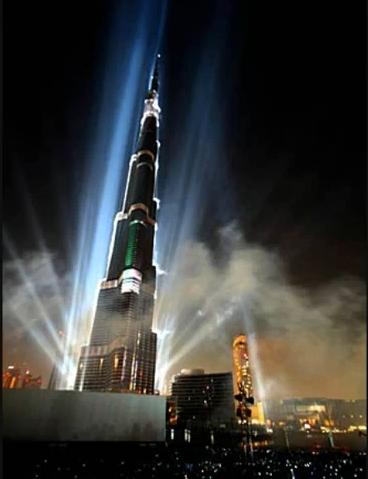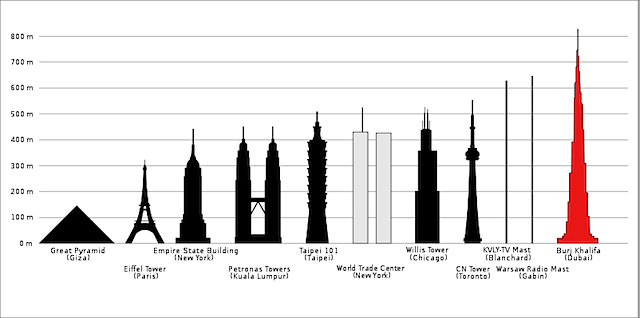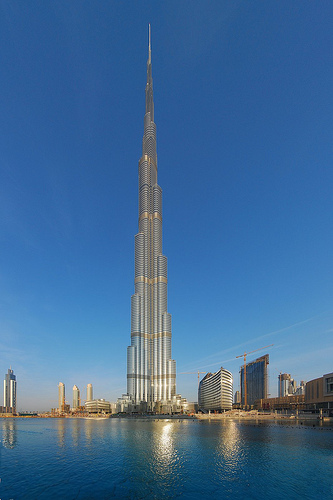Burj Khalifa formerly known as Burj Dubai, is a skyscraper in Dubai, United Arab Emirates, and is the tallest man-made structure ever built, at 828 m (2,717 ft). Construction began on 21 September 2004, with the exterior of the structure completed on 1 October 2009 and the building officially opened on 4 January 2010. The building is part of the 2 km2 (490-acre) flagship development called Downtown Burj Khalifa at the "First Interchange" along Sheikh Zayed Road, near Dubai's main business district. The tower's architect and engineer is Skidmore, Owings and Merrill, LLP (Chicago).

Current records
- Tallest skyscraper to top of spire: 828 m (2,717 ft) (previously Taipei 101 – 509.2 m (1,671 ft))
- Tallest structure ever built: 828 m (2,717 ft) (previously Warsaw radio mast – 646.38 m (2,121 ft))
- Tallest extant structure: 828 m (2,717 ft) (previously KVLY-TV mast – 628.8 m (2,063 ft))
- Tallest freestanding structure: 828 m (2,717 ft) (previously CN Tower – 553.3 m (1,815 ft))
- Building with most floors: 160 (previously both 1 and 2 World Trade Center – 110)
- World's highest elevator installation
- World's fastest elevators at speed of 64 km/h (40 mph) or 18 m/s (59 ft/s) (previously Taipei 101 – 16.83 m/s)
- Highest vertical concrete pumping (for a building): 606 m (1,988 ft) (previously Taipei 101 – 449.2 m (1,474 ft))
- Highest vertical concrete pumping (for any construction): 606 m (1,988 ft) (previously Riva del Garda Hydroelectric Power Plant – 532 m (1,745 ft))
- The first world's tallest structure in history to include residential space
- Highest outdoor observation deck in the world
- World's highest mosque (located on the 158th floor)
- Elevator with the longest travel distance in the world
- Tallest service elevator in the world
- World's highest installation of an aluminium and glass façade, at a height of 512 m (1,680 ft)

Architecture and design
The tower is designed by Skidmore, Owings and Merrill, which also designed the Willis Tower in Chicago, Illinois and 1 World Trade Center in New York City, among numerous other famous high-rises. The building resembles the bundled tube form of the Willis Tower, but is not a tube structure. Its design is reminiscent of Frank Lloyd Wright's vision for The Illinois, a mile-high skyscraper designed for Chicago.
According to Marshall Strabala, an SOM architect who worked on the building's design team, Burj Khalifa was designed based on the 73-floor Tower Palace Three, an all-residential building in Seoul, South Korea. In its early planning, Burj Khalifa was intended to be entirely residential.
Subsequent to the original design by Skidmore, Owings and Merrill, Emaar Properties chose Hyder Consulting to be the Supervision Consultant, Engineer and Architect of Record, for its structural, facade and MEP engineering capability (MEP – mechanical, electrical and plumbing, and encompasses all fire and life safety systems within the building). In this role Hyder Consulting reengineered structural, facades and MEP systems to suit the contractor's and local authority requirements. Hyder Consulting was also responsible for the geotechinical design of Burj Khalifa's foundations with Hyder's own geotechnical specialist, Grahame Bunce heading up a design team that included the world-renowned soil mechanics expert Harry Poulos in a peer-review role. Emaar Properties has also engaged GHD, an international multidisciplinary consulting firm, act as an independent verification and testing authority for concrete and steelwork.

The design of Burj Khalifa is derived from patterning systems[clarification needed] embodied in Islamic architecture. The design architect Adrian Smith has said the triple-lobed footprint of the building was inspired by the flower Hymenocallis. The tower is composed of three elements arranged around a central core. As the tower rises from the flat desert base, setbacks occur at each element in an upward spiralling pattern, decreasing the cross section of the tower as it reaches toward the sky. There are 27 terraces in Burj Khalifa. At the top, the central core emerges and is sculpted to form a finishing spire. A Y-shaped floor plan maximizes views of the Persian Gulf. Viewed from above or from the base, the form also evokes the onion domes of Islamic architecture. During the design process, engineers rotated the building 120 degrees from its original layout to reduce stress from prevailing winds. At its tallest point, the tower sways a total of 1.5 m (4.9 ft).
The spire of Burj Khalifa is composed of more than 4,000 tonnes of structural steel. The central pinnacle pipe weighing 350 tonnes was constructed from inside the building and jacked to its full height of 143 metres using a strand jack system. The spire houses plant and facilitates for communications equipment.
More than 1,000 pieces of art will adorn the interiors of Burj Khalifa, while the residential lobby of Burj Khalifa will have the artwork of 196 bronze and brass alloy cymbals representing the 196 countries of the world. The visitors in this lobby will be able to hear a distinct timbre as the cymbals, plated with 18-carat gold, are struck by dripping water, intended to mimic the sound of water falling on leaves.
The exterior cladding of Burj Khalifa consists of 142,000 m2 (1,528,000 sq ft) of reflective glazing, and aluminium and textured stainless steel spandrel panels with vertical tubular fins. The cladding system is designed to withstand Dubai's extreme summer temperatures. Additionally, at its projected height the exterior temperature at the top of the building will be 6 °C (11 °F) cooler than at its base.
Over 26,000 glass panels were used in the exterior cladding of Burj Khalifa. Over 300 cladding specialists from China were brought in for the cladding work on the tower.
The hotel interior will be decorated by Giorgio Armani. An Armani Hotel, the first of four by Armani, will occupy 15 of the lower 39 floors. Floors through to 108 will have 900 private residential apartments (which, according to the developer, sold out within eight hours of being on the market). An outdoor zero-entry swimming pool will be located on the 76th floor of the tower. Corporate offices and suites will fill most of the remaining floors, except for a 123rd floor lobby and 124th floor (about 440 m (1,440 ft)) indoor and outdoor observation deck. Burj Khalifa is expected to hold up to 25,000 people at any one time. A total of 57 elevators and 8 escalators are installed, the fastest rising and descending at up to 10 m/s (33 ft/s). Engineers had considered installing the world's first triple-deck elevators, but the final design calls for double-deck elevators.
The graphic design identity work for Burj Khalifa is the responsibility of Brash Brands, who are based in Dubai. Design of the global launch events, communications, and visitors centers[44] for Burj Khalifa have also been created by Brash Brands as well as the roadshow exhibition for the Armani Residences, which are part of the Armani Hotel within Burj Khalifa, which toured Milan, London, Jeddah, Moscow and Delhi.
Maintenance
To wash the 24,348 windows, a horizontal track has been installed on the exterior of Burj Khalifa at levels 40, 73 and 109. Each track holds a 1.5 tonne bucket machine which moves horizontally and then vertically using heavy cables. Above level 109, up to tier 27 traditional cradles from davits are used. The top of the spire, however, is reserved for specialist window cleaners, who brave the heights and high winds dangling by ropes to clean and inspect the top of the pinnacle. Under normal conditions, when all building maintenance units will be operational, it will take 36 workers three to four months to clean the entire exterior facade.
Unmanned machines will clean the top 27 additional tiers and the glass spire. The cleaning system was developed in Australia at a cost of A$8 million.
Floor plans
The following is a breakdown of floors.
| Floors | Use |
|---|---|
| 160–206 | Mechanical |
| 156–159 | Communication and Broadcast |
| 155 | Mechanical |
| 139–154 | Corporate Suites |
| 136–138 | Mechanical |
| 125–135 | Corporate Suites |
| 124 | Observatory |
| 123 | Sky Lobby |
| 122 | At.mosphere restaurant |
| 111–121 | Corporate Suites |
| 109–110 | Mechanical |
| 77–108 | Residential |
| 76 | Sky Lobby |
| 44–72 | Residential |
| 43 | Sky Lobby |
| 40–42 | Mechanical |
| 38–39 | Armani Hotel suites |
| 19–37 | Residential |
| 17–18 | Mechanical |
| 9–16 | Armani Residences |
| 1–8 | Armani Hotel |
| Ground | Armani Hotel |
| Concourse | Armani Hotel |
| B1–B2 | Parking, Mechanical |
